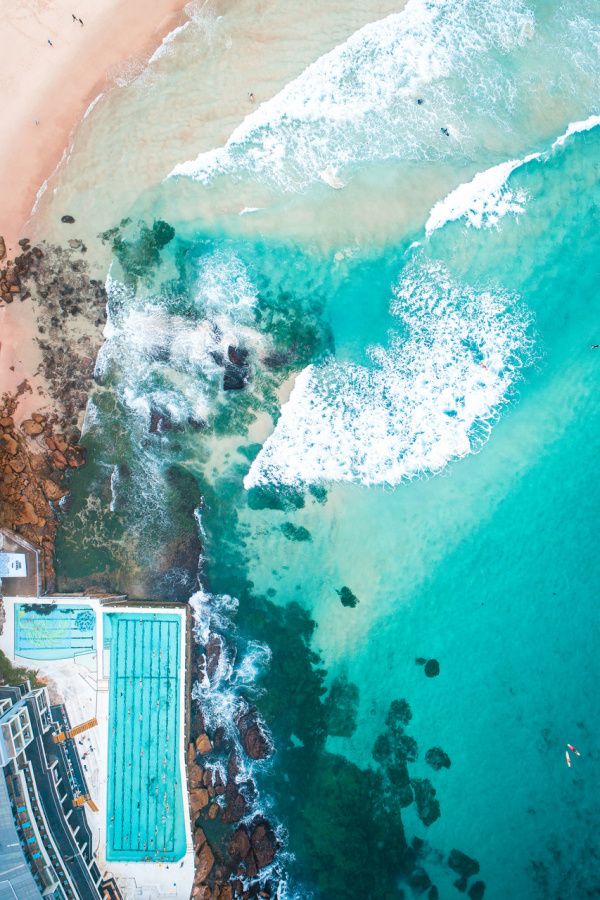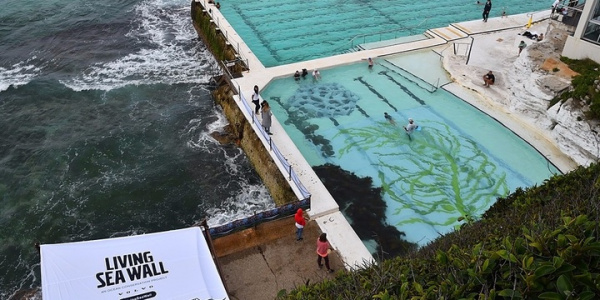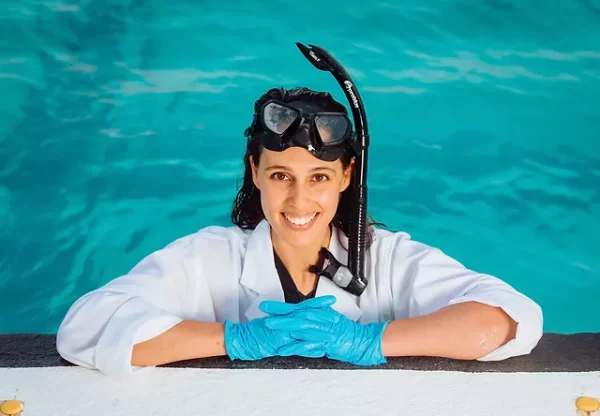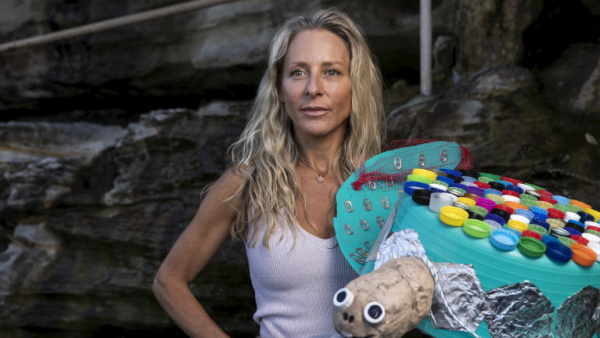
Did you know one acre of algae can remove up to 2.7 tonnes of CO₂ per day? Image Unsplash
- Culture
All hail algae
How this slimy organism could be the solution we have all been looking for
In partnership with Volvo Ocean Lovers Festival
Algae. It’s not really on the sexy side of the marine environment, in fact, if you’ve ever swum in freshwater or the ocean; or wandered over the snow (sans skis), it’s highly likely you’ve done your best to avoid the slippery organism. With up to one million species of algae on planet earth, this family of flora produces around half of all the oxygen we enjoy. As it turns out though, algae plays another enormous role. You see, trees alone aren’t going to save us from the current climate crisis, and when one acre of algae can remove up to 2.7 tonnes of CO₂ per day, we need to take a closer look at algae sequestration as part of our greater climate change solution.
What is algae?
According to Dr. Pia Winberg, Director, CEO and Chief Scientist with Venus Shell Systems algae is the first plant to exist on earth. “(Algae) created the carbon sink that we’re burning up rapidly today over millions of years and created the oxygen we breathe. They have created the whole atmosphere for life on earth as we know it today, and they live with us in cycles; we provide them with CO2 that we breathe out, and they provide us with oxygen. They’re single celled or multiple celled plants but they don’t have roots, vascular tissue, flowers, or seed. They have some different shapes and forms but they’re mostly just bunches of cells stuck together.” And for those wondering what the difference is between algae and seaweed? “Seaweed are algae, they’re just big ones.” Got it.
Algae is part of the solution
For those who believe many of life’s answers already exist within nature, algae will further your case in point. Much like land plants, algae – which can be as small as a microscopic picoplankton, and as large as a 60cm giant sea kelp – use photosynthesis to take in CO₂, water, and sunlight to produce energy. But that’s where the similarities finish. For algae, the energy created through photosynthesis is then exclusively dedicated to self-cloning more algae, and because it doesn’t have stems or roots like other plants, it can replicate quickly. Of course, there are many different types of algae, all serving a different purpose, and just like land plants, some grow fast, while others are slow growing. But when it comes to carbon capture, it’s the green seaweeds that tend to be the most time efficient at their job.
“Algae can regrow 50 times faster than other land plants, so that means that from an area of the planet, you’re absorbing 50 times more carbon, than say a forest or a field of oak trees,” says Dr Winberg. Add that to the fact that algae doesn’t create any waste products and we’ve got ourselves a natural resource that could well be earth’s new hero.
The potential of algae
Imagine for a moment a world with non-polluting plane fuel, clothing and food made from algae, and livestock feed that cuts animals’ greenhouse gas emissions. It’s all within reach. Fast growing, and abounding with unique molecules, algae has a lot of potential.
For Dr Winberg and her team who produce unique, traceable, premium quality marine biomass from the pristine waters of the Tasman Sea, the sky’s (or rather the water’s) the limit. By integrating and sequestering clean carbon dioxide to rapidly grow unique seaweed biomass and extracts, the company is setting global benchmarks with their range of seaweed-based biomaterials, cosmetics, dermatological care, food, nutraceuticals, and pharmaceuticals.
When it comes to their range of pantry essentials, their mission is to replace 10 percent of all foods with seaweed. “If we do that, we’re replacing the footprint of 10 percent of other foods. Take wheat for example, 10 percent of wheat in Australia would be a million hectares of land that would be freed up, that you don’t need to put pressure on anymore with fossil carbon inputs or freshwater use; we’re not sinking the carbon but we’re reducing the carbon footprint of our food production by replacing 10 percent of our food with seaweed.”
Our diets can be quite deficient in minerals such iodine and iron, and we can get those minerals either from seaweed itself or from seaweed delivering nutrition and health back to the land and working as a soil health product. “If we put seaweed at the soil and plant roots there’s a lot of research showing how important the soil microbes benefit from having seaweed in the soil as well,” explains Dr Winberg. In addition to being healthy and nutritious in the human gut, algae can also help to improve the gut flora in animals so they’re able to reduce antibiotic intake and maintain healthy gut pathogens.
But algae doesn’t stop there. As well as a promising source for making biofuels and bioplastics when it comes to high tech biomaterials, Dr. Winberg and her team are on the forefront of further exploratory work. “We’re doing research in human tissues and wound repair, so we can actually 3D print seaweed inks that we’ve invented, print them with human cells and recreate skin tissues,” she says.
All that and we haven’t even touched on the global fashion industry.
In a big step towards sustainable fashion, scientists are now developing biodegradable, carbon-capturing textile from algae. In February this year, Australian brand Piping Hot Australia and the University of Technology Sydney (UTS) announced their research partnership to develop a sustainable fibre made from seaweed. In a move that could transform the global polyester industry, Piping Hot have commissioned UTS climate scientists to build an innovative prototype fibre; a biobased solution that will sequester carbon from the ocean and reduce the environmental impact of synthetic fibres.
“As part of Piping Hot’s mission to defend the oceans, our purpose-led investment into marine biotechnology and material science is of vital importance. Together we intend to impact change through marine science and transform the industry’s reliance on fossil fuels,” says Stan Wan CEO and Managing Director of Piping Hot Australia.
Bio-textiles like this could most certainly give our environment respite from the inconceivable pressure the fashion industry has placed on it. “Developing new nature-derived alternatives for the fashion and textile industries has the potential to revolutionise products and their impact on the oceans,” concurs Distinguished Professor Peter Ralph, Director, UTS Climate Change Cluster.
As we learn more about algae it would seem there are exciting prospects at every turn. And that goes for the building industry too. Biotechnologists are investigating biofuels as alternatives to fossil fuels, and while some, like corn, soybean and sugarcane add to water scarcity and deforestation, micro algae has a chance to shine in our built environment. Take the microalgae covered in magnificent and intricate silica shells for (one small) example. “These shells guide light to the algae cells in the most efficient of ways and scientists are now looking to utilise silica shells and microalgae to make solar panels because of the efficient way they guide light,” says Dr Winberg. It’s hard to deny that nature holds so many of the answers.
What next?
It’s uncharted territory but it’s an exciting industry to champion from the sideline. High in nutrients, vitamins, and proteins, over time algae can and will be utilised in several different ways to reduce carbon in the atmosphere; many of those ways we’re still yet to discover. But while we eagerly watch this space, remember that every little bit helps, so consider purchasing products made from algae and opt into the next waterway cleanups if you get the opportunity.
THE VOLVO OCEAN LOVER’S FESTIVAL
Staged at Sydney’s iconic Bondi Beach, the Volvo Ocean Lover’s Festival is three full days of free entertainment and events between April 22 – April 24, 2022. A community event founded in 2019 by Anita Kolni and a local team of ocean lovers, the annual festival showcases successful marine projects restoring the coastal ecology, supports ocean innovating entrepreneurs, promotes indigenous coastal care and provides a platform to ocean champions, marine scientists, government initiatives and community groups.
Our oceans cover more than 70 per cent of the earth’s surface; and this festival gives all of us an opportunity to understand how vital marine environments are to the planet. It’s a practical opportunity for adults and children to immerse themselves in an understanding of the ocean and the significance of clean seas and restored ecosystems. Beyond inspiring action and behavioural change, it’s designed to bring awareness and action for the oceans to the widest possible audience.

KEY EVENTS OF THE FESTIVAL
CRAYWEED INSTALLATION
Get underwater, up close, and personal at the Crayweed Installation. Set in Bondi Icebergs swimming pool, Operation Crayweed has recreated a restoration site with a small subset of crayweed to demonstrate the transplantation and restoration process. So, don your swimmers, grab a snorkel, and enjoy this immersive installation.
“It can be easy to ignore underwater ecosystems because you can’t see them until you’re under the water’s surface; but not everyone is comfortable jumping off the rocks and into the ocean, or diving into the seaweed reefs to have a closer look. Having the Crayweed Installation in an accessible environment like Bondi Icebergs where people can submerge under water and engage with the ocean will be hugely beneficial,” explains Langley.
The other aspect of this exhibit is Living Seawalls, a project coming out of the Sydney Institute of Marine Science which aims to bring biodiversity back to artificial structures in urbanised areas. Instead of having dimension-less structures or flat sea walls that are the boundary between the land and the harbour, Living Seawalls are beautifully printed tiles which you can install onto walls.
‘These tiles feature lots of nooks and crannies that mimic natural habitat like sandstone-barnacles, and we’ll have example tiles in the pool as well so people can touch them, see them, and interact with them. We’ll also feature giant artworks of Crayweed and the Living Seawall in the pool,” says Langley.
Register to attend the Crayweed Installation here.

SCIENCE IN YOUR SWIMMERS
Curated by Fizzics Education, over 20 scientists will share their research knowledge in the Ocean Lab and on the Sunshine Stage each day between 11 am to 1pm. Beachgoers can literally turn up in their swimmers to hear from scientists and join free science workshops for kids and adults, and to find out what scientific topics are inspiring the next generation. Meet the scientists working with Sydney Institute of Marine Science.

IMMERSIA FREEDIVING
Learn to freedive! Ocean lovers will also get to explore Bondi’s hidden side – beneath the waves. This four-hour taster course will show you how to use breathing and mental techniques to extend your breath-hold and relieve stress, how to duck-dive and equalise your ears so you can dive deeper, how to understand and respect the ocean environment, and how to keep yourself and your buddies safe in the water.

LITTERARTY SCHOOL WASTE ART COMPETITION EXHIBITION
Come and view an art exhibition with a twist. School students around Australia of all ages have been invited to repurpose rubbish into prize-winning artworks with this exhibition featuring the finalists of this creative competition. The competition promotes concepts about closed loop recycling, litter and rubbish impacts on the ocean and creative and thoughtful ways to make better everyday decisions by turning trash to treasure.

*Green + Simple is a media partner of the Volvo Ocean Lover’s Festival
RELATED: 5 things you can do to reduce your carbon footprint
RELATED: Sam Elsom is changing the world, one seaweed plant at a time
